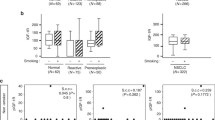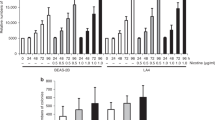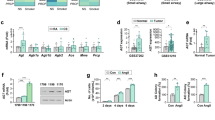Abstract
Purpose: Pancreatic ductal adenocarcinoma is an aggressive smoking-associated human cancer in both men and women. The nicotine-derived 4-(methylnitrosamino)-1-(3-pyridyl)-1-butanone (NNK) is thought to contribute to the development of these neoplasms in smokers through genotoxic effects. However, NNK has been recently identified as an agonist for both β1- and β2-adrenergic receptors. Binding of NNK to these receptors stimulates proliferation of pulmonary and pancreatic adenocarcinomas cells in vitro and in hamster models. The goal of this study was to elucidate the NNK effects on the signal transduction pathways downstream of both β1- and β2-adrenergic receptors in immortalized human pancreatic HPDE6-c7 cells. Methods: The HPDE6-c7 cells are developed from normal pancreatic duct epithelial cells which are the putative cells of origin of pancreatic ductal adenocarcinoma. 3-(4,5-dimethylthiazol-2-yl)-2,5-diphenyl-tetrazoliumbromide (MTT) cell proliferation assays, Western blot and cyclic AMP assays were employed to demonstrate the effects of NNK and other β1- and β2-adrenergic agonists and antagonist treatments on these cells. Results: MTT cell proliferation assays demonstrated that NNK and the classic β-adrenergic agonist, isoproterenol, increased cell proliferation in HPDE6-c7 cells. Western blot and cyclic AMP assays demonstrated that NNK treatments also resulted in: (1) transactivation of the epidermal growth factor receptor, EGFR, (2) an increase in intracellular cyclic AMP accumulation, and (3) phosphorylation of mitogen-activated protein kinase, Erk1/2. The proliferative response to NNK and isoproterenol were inhibited by the use of beta-blockers (propranolol), and the inhibitors of adenylyl cyclase (SQ 22536), EGFR-specific tyrosine kinase (AG 1478) and Erk (PD 98059). Conclusion: These findings suggest that the NNK -mediated β-adrenergic receptor transactivation of the EGFR and phosphorylation of Erk1/2 in immortalized human pancreatic duct epithelial cells as a novel mechanism might contribute to the development of tobacco-associated pancreatic carcinogenesis.








Similar content being viewed by others
Abbreviations
- AA:
-
Arachidonic acid
- AG1478:
-
4-(3-Chloroanillino)-6,7-dimethoxyquinazoline
- EGFR:
-
Epidermal growth factor receptor
- ERK:
-
Extracellular signal-regulated kinase
- GPCR:
-
G protein-coupled receptors
- IBMX:
-
3-isobutyl 1-methylxanthine
- NNK:
-
4-(methylnitrosamino)-1-(3-pyridyl)-1-butanone
- MAPK:
-
Mitogen-activated protein kinase
- MTT:
-
3-(4,5-dimethylthiazol-2-yl)-2,5-diphenyl-tetrazoliumbromide
- PD98059:
-
2′-amino-3′methoxyflavone
- SQ 22536:
-
9-(tetrahydro-2-furanyl)−9 H-6-amine
References
Miller BA, Silverman DT, Kaplan R (1993) Pancreas. Cancer Statistics Review: 1973–1990. In: Miller BA, Ries LA, Hanky BF et al (eds) Bethesda, NIH Publication #93–2789, NCI
Gold EB, Cameron JL (1993) Chronic pancreatitis and the risk of pancreatic cancer. N Engl J Med 323:1485–1486
Lowenfels AB, Maisonneuve P, Cavalline G et al (1993) The International Pancreatic Study Group. Pancreatitis and risk of pancreatic cancer. N Engl J Med 328:1433–1437
Hecht SS (1996) Recent studies on the mechanisms of bioactivation and detoxification of 4-(methylnitrosamino)-1-(3-pyridyl)-1-butanone (NNK), a tobacco-specific lung carcinogen. CRC Cri Rev Toxicol 26:163–181
Belinsky A, Devereux TR, Maronpot RR, Stoner GD, Anderson MW (1989) The relationship between the formation of promutagenic adducts and the activation of the K-ras protooncogene in lung tumors from A/J mice treated with nitrosamines. Cancer Res 40:5305–5311
Sakorafas GH, Tsiotou AG, Tsitos GG (2000) Molecular biology of pancreatic cancer; oncogenes, tumor suppressor genes, growth factors, and their receptors from a clinical perspective. Cancer Treat Rev 26:29–52
Schuller HM, Zhang L, Weddle DL, Castonguay A, Walker K, Miller MS (2002) The cyclooxygenase inhibitor ibuprofen and the FLAP inhibitor MK886 inhibit pancreatic carcinogenesis induced in hamsters by transplacental exposure to ethanol and the tobacco carcinogen NNK. J Cancer Res Clin Oncol 128:525–532
Ikematsu Y, Liu G, Fienhold MA et al (1997) In vitro pancreatic ductal cell carcinogenesis. Int J Cancer 72:1095–1103
Schuller HM, Tithof PK, Williams M, Plummer III HK (1999) The tobacco-specific carcinogen 4-(methylnitrosamino)-1-(3-pyridyl)-1-butanone is a ß-adrenergic agonist and stimulates DNA synthesis in lung adenocarcinoma via ß-adrenergic receptor-mediated release of arachidonic acid. Cancer Res 59:4510–4515
Weddle DL, Tithoff P, Williams M, Schuller HM (2001) Beta-adrenergic growth regulation of human cancer cell lines derived from pancreatic ductal carcinomas. Carcinogenesis 22:473–479
Novak I (1998) Beta-adrenergic regulation of ion transport in pancreatic ducts: patch-clamp study of isolated rat pancreatic ducts. Gastroenterology 115:714–721
Alvarez C, Regan JP, Bass BL (2002) Influence of epidermal growth factor on bovine pancreatic duct cell bicarbonate. J Surg Res 106:54–61
Tobita K, Kijima H, Dowaki S et al (2003) Epidermal growth factor receptor expression in human pancreatic cancer: significance for liver metastasis. Int J Mol med 11:305–309
Clarke LE, Leitzel K, Smith J, Ali SM, Lipton A (2003) Epidermal growth factor receptor mRNA in peripheral blood of patients with pancreatic, lung and colon carcinomas detected by RT-PCR. Int J Oncol 22:425–430
Ouyang H, Mou Lj, Luk C, Liu N, Karaskova J, Squire J, Tsao MS (2000) Immortal human pancreatic duct epithelial cell lines with near normal genotype and phenotype. Am J Pathol 157:1623–1631
Daaka Y, Luttrell LM, Lefkowitz RJ (1997) Switching of the coupling of the beta2-adrenergic receptor to different G proteins by protein kinase A. Nature 390:88–91
Maudsley S, Pierce KL, Zamah AM et al (2000) The beta(2)-adrenergic receptor mediates extracellular signal-regulated kinase activation via assembly of a multi-receptor complex with the epidermal growth factor receptor. J Biol Chem 275:9572–9580
Luttrell LM (2002) Activation and targeting of mitogen-activated protein kinases by G-protein-coupled receptors. Can J Physiol Pharmacol 80:375–382
Borda ES, Tenenbaum A, Sales ME, Rumi L, and Sterin-Borda L (1998) Role of arachidonic acid metabolites in the action of a ß adrenergic agonist on human monocytes. Prostaglandins leukotrienes essent. Fatty Acids 58:85–90
Schlosser W, Schlosser S, Ramadani M, Gansauge F, Gansauge S, Beger HG (2002) Cyclooxygenase-2 is overexpressed in chronic pancreatitis. Pancreas 25(1):26–30
Schuller HM, Porter B, Riechert A (2000) Beta-adrenergic modulation of NNK-induced lung carcinogenesis in hamsters. J Cancer Res Clin Oncol 126:624–630
Schuller HM (2002) Mechanisms of smoking-related lung and pancreatic adenocarcinoma development. Nat Rev Cancer 2:455–463
Treisman R (1996) Regulation of transcription by MAP kinase cascades. Curr Opin Cell Biol 8:205–215
Garrington TP, Johnson GL (1999) Organization and regulation of mitogen-activated protein kinase signaling pathways. Curr Opin Cell Biol 11:211–221
Daub H, Weiss FU, Wallasch C, Ullrich A (1996) Role of transactivation of the EGF receptor in signalling by G-protein-coupled receptors. Nature 379:557–560
Daub H, Wallasch C, Lankenau A, Herrlich A, Ullrich A (1997) Signal characteristics of G protein-transactivated EGF receptor. EMBO J 1:7032–7044
Luttrell LM, Della Rocca GJ, van Biesen T, Luttrell DK, Lefkowitz RJ (1997) J Biol Chem 272:4637–4644
Korc M (1998) Role of growth factors in pancreatic cancer. Surg Oncol Clin N Am 7:25–41
Korc M, Chandrasekar B, Yamanaka Y, Friess H, Büchler MW, Beger HG (1992) Overexpression of the epidermal growth factor receptor in human pancreatic cancer is associated with concomitant increases in the levels of epidermal growth factor and transforming growth factor alpha. J Clin Investig 90:1352–1360
Zhu Z, Kleeff J, Friess H, Wang L et al (2000) Epiregulin is up-regulated in pancreatic cancer and stimulates pancreatic cancer cell growth. Biochem Biophys Res Commun 273:1019–1024
Piiper A, Dikic I, Lutz MP, d Zeuzem S (2002) Cyclic AMP induces transactivation of the receptors for epidermal growth factor and nerve growth factor, thereby modulating activation of MAP kinase, Akt, and neurite outgrowth in PC12 cells. J Biol Chem 277:43623–43630
Park PG, Merryman J, Orloff M, Schuller HM (1995) Beta-adrenergic mitogenic signal transduction in peripheral lung adenocarcinoma: implications for individuals with preexisting chronic lung disease. Cancer Res 55:3504–3508
Acknowledgements
Grant support: This work was supported by Public Health Service Grant RO1 CA042829 with the National Cancer Institute.
Author information
Authors and Affiliations
Corresponding author
Rights and permissions
About this article
Cite this article
Askari, M.D.F., Tsao, MS. & Schuller, H.M. The tobacco-specific carcinogen, 4-(methylnitrosamino)-1-(3-pyridyl)-1-butanone stimulates proliferation of immortalized human pancreatic duct epithelia through β-adrenergic transactivation of EGF receptors. J Cancer Res Clin Oncol 131, 639–648 (2005). https://doi.org/10.1007/s00432-005-0002-7
Received:
Accepted:
Published:
Issue Date:
DOI: https://doi.org/10.1007/s00432-005-0002-7




